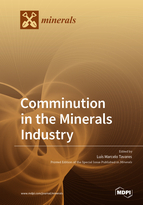Comminution in the Minerals Industry
A special issue of Minerals (ISSN 2075-163X). This special issue belongs to the section "Mineral Processing and Extractive Metallurgy".
Deadline for manuscript submissions: closed (1 August 2020) | Viewed by 59664
Special Issue Editor
Interests: mineral processing; modeling; simulation; comminution; physical concentration; coal preparation; discrete element method; degradation during handling; particle breakage
Special Issues, Collections and Topics in MDPI journals
Special Issue Information
Dear Colleagues,
Size reduction processes, which encompass crushing and grinding, represent a significant part of the capital as well as of the operational cost in ore processing. Improving and further understanding such processes is worthwhile, since any measurable improvement may lead to benefits to the process, be they a reduction in energy consumption, wear, or improved performance in downstream processes. Contributions dealing with the various aspects of comminution are encouraged, including understanding of ore breakage, modeling, simulation, control, plant practice, novel comminution and ore pretreatment technologies, as well as downstream implications of comminution processes.
Prof. Dr. Luís Marcelo M. Tavares
Guest Editor
Manuscript Submission Information
Manuscripts should be submitted online at www.mdpi.com by registering and logging in to this website. Once you are registered, click here to go to the submission form. Manuscripts can be submitted until the deadline. All submissions that pass pre-check are peer-reviewed. Accepted papers will be published continuously in the journal (as soon as accepted) and will be listed together on the special issue website. Research articles, review articles as well as short communications are invited. For planned papers, a title and short abstract (about 100 words) can be sent to the Editorial Office for announcement on this website.
Submitted manuscripts should not have been published previously, nor be under consideration for publication elsewhere (except conference proceedings papers). All manuscripts are thoroughly refereed through a single-blind peer-review process. A guide for authors and other relevant information for submission of manuscripts is available on the Instructions for Authors page. Minerals is an international peer-reviewed open access monthly journal published by MDPI.
Please visit the Instructions for Authors page before submitting a manuscript. The Article Processing Charge (APC) for publication in this open access journal is 2400 CHF (Swiss Francs). Submitted papers should be well formatted and use good English. Authors may use MDPI's English editing service prior to publication or during author revisions.
Keywords
- crushing
- grinding
- fragmentation
- particle breakage
- pre-weakening
- milling
- cone crushing
- modeling
- simulation
- ball milling
- semi-autogenous milling
- autogenous milling
- roller pressing
- roll crushing
- impact crushing
- ultrafine grinding






